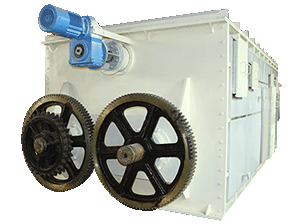In order to increase the drying rate and prevent uneven drying, mechanical agitation or the rotation of the container itself is usually used to increase or continuously update the heat transfer surface of the material, so it is necessary to further study the adhesion problem of the heat transfer mechanism. The drying unit itself is expensive, but it is characterized by a small load on the dust collecting system, high thermal efficiency, easy recovery of the solvent, and the total cost is much cheaper than the direct drying method.
(1) Belt dryer
The belt dryer consists of several independent unit sections. Each unit section includes a circulating fan, a heating device, a separate or common fresh air intake system, and an exhaust gas exhaust system. The operating parameters of the amount of drying medium, temperature, humidity and tail gas circulation can be independently controlled to ensure the reliability of the operation of the dryer and the optimization of operating conditions. The operation with the dryer is flexible, the wet material is fed, and the drying process is carried out in a completely sealed box, and the labor conditions are good, and the leakage of dust is avoided. It is used for the drying of flake, strip and granular materials with good gas permeability. It is especially suitable for materials such as dehydrated vegetables and traditional Chinese medicine decoction pieces with high water content and high material temperature.
(2) Roller scraper dryer
The drum scraper dryer is a continuous operation device for drying a liquid material or a strip material attached to the outer wall of the cylinder by means of a rotating cylinder in a heat conduction manner. The liquid to be dried is flowed from the high level tank into the receiving tank of the drum dryer. The drying drum is driven by the transmission and rotates at a specified speed. The material is formed by a film coating device to form a film on the wall surface of the drum. The heating medium is continuously introduced into the cylinder, and the cylinder body is heated, and the moisture of the film is vaporized by the heat transfer of the cylinder wall, and then the material which meets the drying requirement is scraped off by a scraper, and is spirally conveyed into the storage tank for packaging. The moisture removed by evaporation can be introduced into the corresponding treatment device through a closed cover depending on its nature; it is generally water vapor, which can be directly discharged into the atmosphere by the exhaust pipe at the top of the cover. The machine is mainly used for the treatment of liquid materials, which can be heated and dried by steam, hot water or hot oil, and can be cooled by cold water. Immersion, spray, and milled auxiliary feeding methods can be used according to different material properties and process requirements.
(3) Hollow paddle dryer (blade dryer)
The hollow blade dryer, also known as the blade dryer, is mainly composed of a W-shaped casing with a jacket and two hollow blade shafts and a transmission device. Hollow blades are arranged on the shaft, and the rotary end of the heat medium is introduced at the shaft end. The heat required to dry the water is conducted to the material by the inner wall of the jacketed W-shaped groove and the hollow blade wall. During the drying process, the hollow shaft with hollow blades agitates the material while heating the material, thereby updating the heating surface. It is a continuous conduction heating dryer. The heating medium is steam, hot water or heat transfer oil. The heating medium is introduced into the casing jacket and the two hollow blade shafts to heat and dry the materials in a conductive manner, and the hollow shaft structure of the different materials is different.
The machine is suitable for processing various materials with good thermal stability such as paste, granules and powder. Under special conditions, the heat sensitive material can be dried and the solvent can be recovered during the drying process. It is commonly used for drying or cooling materials such as carbon black, light calcium carbonate, titanium dioxide, barium carbonate, nitrile uric acid, gypsum, clay, manganese dioxide, nylon and polyester chips, polyethylene, polypropylene (recovery solvent).
(4) Vacuum dryer
The dry material is added from the upper part of the top of the vacuum squeezing dryer. When the material is in contact with the shell wall under the stirring of the rotating dent, the surface is continuously updated, and the dried material is subjected to steam (or hot water, heat transfer oil). Indirect heating, but the moisture of the material is vaporized, and the vaporized water is pumped away by the vacuum pump in time. The dried material is indirectly heated by the heat carrier to vaporize the water in the material, and the vaporized water is discharged by the vacuum pump in time.
Due to the high operating vacuum, generally in the range of 400-700 mmHg, the water vapor pressure on the surface of the dried material is much larger than the water vapor pressure in the evaporation space in the dryer housing. Thereby, it is beneficial to the discharge of the internal moisture and the surface water of the material to be dried, which is beneficial to the movement of the water molecules of the dried material to achieve the purpose of drying. The vacuum kneading dryer is suitable for heat-sensitive materials that are easily oxidized at high temperatures or materials that are easily smeared during drying, and materials that must be recovered from steam discharged during drying. Typical dry materials are sodium propylene sulfonate, CMC, phthalocyanine blue, dye intermediates, carboxymethyl starch, maltodextrin, hydrazine sulfonic acid and the like.
(5) Double cone rotary vacuum dryer
The double-cone rotary vacuum dryer has a slightly olive-like shape with a cover at both ends, and two shafts are arranged in the middle to support the body. The body has a jacket for heating, and the body can be rotated when dry, so that the material and the wall are frequently replaced, which overcomes the disadvantage that the material in the vacuum oven is mainly guided by the heating cylinder and has low thermal efficiency. Rotary vacuum dryers have been widely used in fine chemicals and medicines, and are not suitable for materials with high viscosity or strong adhesion during the turning process. The equipment is mainly used for concentrating, mixing, drying and low-temperature drying materials (such as biochemical products) of powder, granular and fibrous materials in the pharmaceutical, chemical and food industries, and is more suitable for oxidizing, volatile and heat sensitive. Strongly irritating, toxic materials and drying of materials that do not allow damage to the crystals.
(6) Spray dryer
Spray drying is the most widely used process in the liquid process forming and drying industry. It is most suitable for the production of powdery, granular solid products from solutions, emulsions, suspensions and paste liquid materials. Therefore, spray drying is an ideal process when the particle size distribution, residual moisture content, bulk density and particle shape of the finished product must meet exact standards.
(7) Vacuum oven
Since the evaporation temperature of the volatile matter contained in the evaporation of the material can be reduced after decompression, it is suitable for drying various heat sensitive and easy oxide materials. This device is often a cylinder or other vacuum-operated outer casing. It is heated by electric heating or hot water or heat-conducting oil through a heating plate or a heating pipe, and is suitable for batch production in small batches.
The oven is a general-purpose drying equipment with a wide application surface. It is a tray-type intermittent drying equipment and is used in pharmaceutical, chemical and food. Heat curing, drying and dehydration of materials and products in light industry, heavy industry and other industries. Such as raw materials, biopharmaceuticals, Chinese herbal medicines, extracts, powders, granules, granules, water pills, packaging bottles, pigment dyes, dehydrated vegetables, dried fruits, sausages, plastic resins, electrical components, baking varnishes, etc.
(8) Rotary flash dryer
The material to be dried enters the drying chamber through the screw input device, and is pulverized by the stirring paddle at the lower part of the dryer. The pulverized material is in full contact with the hot air, flows upward and is dried under the double action of the stirring paddle and the airflow distributor, and passes through the classifier. Screen the material with acceptable particle size and humidity and spin it down until it is qualified.
Product features: fast drying speed. The dryer can be completed in 1-10 seconds; the material residence time can be adjusted. It can be adjusted between 1-500s, suitable for drying of heat-sensitive materials; a variety of feeding devices are available for selection, the feeding is continuous and stable, and no bridging phenomenon occurs; the circumferential air velocity in the drying chamber is high, the material residence time is short, and the material is effectively prevented. The sticky wall and the heat sensitive material are deteriorated; the drying chamber is equipped with a grading ring and a swirling sheet, and the material fineness and the final moisture are adjustable and controllable; the drying strength is high.



